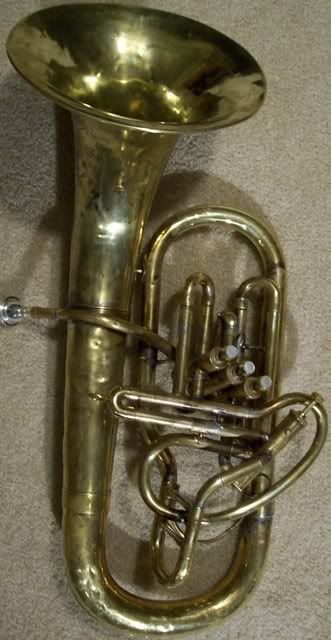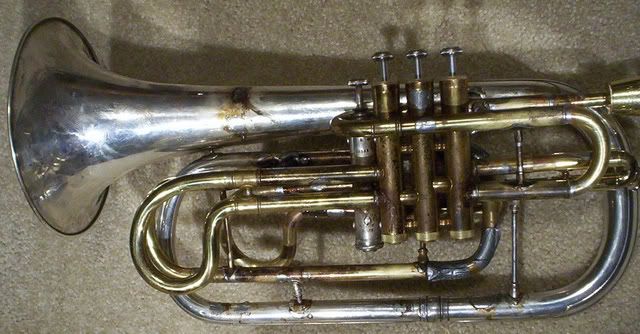EuphoniumPlayer87 wrote:I have no authority on this, but I have wondered the same question. My personal answer is that there is ONE way to make a modern euphonium practical.
The 3+1P compensating euphonium certainly appears to have almost monopolised the market. I don't disagree with the market, as my own euph follows the same pattern, which locks the potentials of creative designs down to details.
The leadpipe cannot be much shorter for practical reasons. It can't be much longer either, as that would lead to a very large bore through the first 3 valves, or the mouthpiece stem should be rather narrow, if the leadpipe shall be conical.
As there shall be a not too abrupt bore increase between the 3rd and the 4th valves the 3+1 concept comes more natural than the 4 front action versions, where a pre-WWII British prototype had an extra loop between these pistons. The same can be seen on the 983 Besson Eb tuba.
When it comes to the 4th valve loop there appear to be two variants. One has a uniform bore through all of that loop. Yamaha and possibly other makers use a conical bow in the 4th valve tuning slide. That calls for a fairly abrupt bore expansion in the 4th piston air passage, when that piston is not activated. Normally such fast bore increases are not desirable, but I have not experienced disadvantages on my YEP-641.
The 3+1P Blaikley compensating system was developed to circumvent the acoustical/mathematical faults, which come up, when valves are activated simultaneously. The 1+2 combination comes out sharp on certain partials. Some playing/teaching traditions correct that by using the 3rd valve as an alternative. The 2+3 combination also is experienced sharp by some players, whereas others find this error being easily corrected by lipping. Some makers apply a compromise insofar that they make the 2nd valve loop slightly longer than it should ideally be for a perfect semitone lowering of the open bugle.
The rather sharp 1+3 combination can always be avoided by using the 4th valve, which theoretically changes the compensating euphonium into a tiny 3 valve F tuba. On this virtual F tuba the combinations of 1+3(+4) and 1+2+3(+4) are noticeably sharp. Some players call these notes of low C and low B natural very stuffy. In my experience based on the use of a large mouthpiece, this stuffiness is a result of the attempts to lip these notes into proper tuning. As said this virtual F tuba already is small. When almost half of the applied tubing then is made up of cylindrical tubing, then flexibility becomes very small, and the buzz of the proper pitch will find no resonance.
For 20 years or more Hirsbrunner has offered a trigger system simultaneously lengthening the 1st and 3r slide loops. It takes some force to activate and it can lead to funny compression or decompression sounds if the pistons are not vented. Another approach was introduced as a custom option by the Japanese division of B&H and endorsed by Steven Mead: the main tuning slide trigger. Coming from the bass trombone I was accustomed to do a lot of scale and legato work around the pedal note to achieve evenness of sound and intonation in that range, which I also used on the euph as the swing man in a small concert band. That was the rationale for my investment in an after market installation of such trigger. According to SM his main use of that trigger was the improvement of the 6th partial sharp range. Anyway I like that trigger very much, even if it at first confused my left thumb, which believed this was the 4th valve trigger like on the bassbone. Some very funny split notes came up.
For many years I have had an idea, which should give a perfect low C on the euphonium. I have aired it in various places, but as it takes a recalculation of the main bugle properties it has found no takers so far: the well known 3+1P Blaikley euphonium should have a 5th valve added which should be triggered by the left middle finger. This should be an ascending whole step valve putting the main bugle into C. This valve could be applied in all ranges to optimise sound and intonation on problem notes. The concept has been used on French horns in France and prominent horn makers like Alexander and Paxman still make such models.
The sore spot of applying this idea to the euphonium is the introduction of another cylindrical portion of tubing to the main bugle. This problem partially could be circumvented by making that 5th valve a double valve shunting the airpath between two different lengths of conical tubing. Such double valves are known from triple horns and from a very few double horns. There the synchronisation of two rotors takes very exact and vulnerable adjustments. A piston version could be inspired by the Wiener Pumpen known from the VPO horns. Anyway an ascending valve added to the current 3+1P euph concept would be very expensive.
Klaus Smedegaard Bjerre






